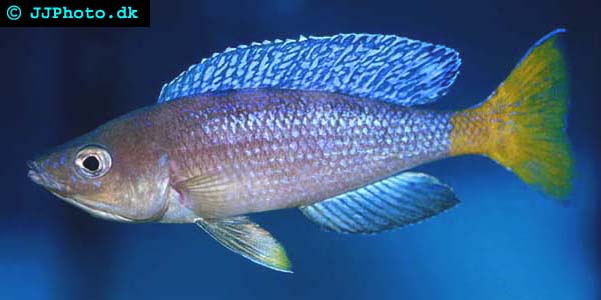Cyprichromis leptosoma
Cyprichromis leptosoma was earlier known as Limnochromis leptosoma, but has now been moved to the genus Cyprichromis. The same thing happened to three closely related species previously known as Limnochromis brieni, Limnochromis nigripinnis and Limnochromis microlepidotus – they are now named Cyprichromis brieni, Cyprichromis nigripinnis and Cyprichromis microlepidotus. All the members of the genus Cyprichromis are endemic to Lake Tanganyika and needs hard alkaline conditions in the aquarium.
Description
Both sexes have strong, torpedo shaped bodies and are vigorous swimmers and jumpers. The male is of a light silvery brown color and sport a yellow tail, a blue dorsal fin with black markings, and blue pelvic and anal fins with yellow tips. The female fish looks plainer; her body is light brown and there is just a hint of silver on her head and sides.
Behavior and suitable housing
Just like the other members of the genus Cyprichromis, Cyprichromis leptosoma is a fairly peaceful fish that must be kept in a school. It is not territorial but a large aquarium of 36 inches or more is still recommended since these fishes need a lot of place to swim around in. The like to stay close to the surface and are agile jumpers so a secure lid is necessary. Cyprichromis leptosoma will appreciate broad leafed plants to seek shelter under. You can often see them right under broad leaves in the aquarium, their bodies tilting down at a 45 degree angle with the head pointing towards the bottom.
Water
Cyprichromis leptosoma is native to Lake Tanganyika and will consequently do best in hard alkaline conditions. In this lake, a majority of the dissolved salts that makes the water hard are derived from carbonates of calcium, magnesium and sodium.
Feeding
Keep your Cyprichromis leptosoma fishes on varied diet to promote breeding and optimal health. You can for instance use high quality flakes or pellets as a base and supplement with plenty of brine shrimp, blood worms and similar.
Breeding Cyprichromis leptosoma
Cyprichromis leptosoma is a surface spawning mouthbrooder. In the wild, the fish will usually jump a lot during courtship, but this can naturally be impossible in captivity. The actual spawning takes place out in the open water and the female will pick up the eggs as soon as they have been released. The male will then deliver a mouthful of sperm that fertilizes the eggs. Incubation lasts for roughly three weeks and the fry is developed enough to be free swimming as soon as they are released. None of the parents engage in any fry care once the fry has been spitted.
Cyprichromis leptosoma fry can be fed daphnia, newly hatched brine shrimp and powdered flake food. Carry out small and frequent water changes to keep the water quality up without causing dramatic changes in water chemistry.

Cyprichromis leptosoma.
Picture added by AC tropical fish. Copyright www.jjphoto.dk
Didn't find the info you were looking for? Register for free and ask your question in our Aquarium forum !
Our knowledgeable staff usually responds to any question within 24 hours
Related Articles
Fairy Cichlid - Neolamprologus brichardi - keeping Neolamprologus brichardiBreeding Julidochromis - Information about Breeding Julidochromis
Feeding Lake Tanganyika cichlids - Information that will help you give your fish a good diet.
Telmatochromis bifrenatus - Care and Breeding of Telmatochromis bifrenatus
Tanganyika Cichlids: Cavity brooders - Information about Cavity brooders
Julidochromis - Information about Julidochromis
Weird and Wonderful Tanganyika Cichlids - An interesting article about different Lake Tanganyika cichlids.
Lake Tanganyika and the Tanganyika cichlids - Information about Lake Tanganyika and the Tanganyika cichlids
Lake Tanganyika Cichlids - There are three biotopes: Open Water, Rocky, and Shell Beds. Each attracts a different fish, which are kept diffrently
Tanganyika Cichlids:Mouth brooders - Information about Mouth brooders
Tanganyika Cichlids:Shell Dwellers - Information about Shell Dwellers
Spawning Aulonocranus dewindti 'Ikola Honey Strain' - Information on keeping and breeding this Lake Tanganyikan mouthbrooder.
Breeding Cyphotilapia frontosa - Breeding Cyphotilapia frontosa
Tanganyika Cichlids - Information about Tanganyika Cichlids
Tanganyika Cichlid Habitats - A guide to the different biotopes in Lake Tanganyika.
Tropheus brichardi 'Mpimbwe' - How to keep and breed this beatiful fish.
Tropheus duboisi 'Maswa' - How to keep this tropheus..
Tropheus moorii - My Experiences - Keepin and breeding Tropheus.
Tropheus sp. - Information about how to keep and breed tropheus sp.
Tropheus sp. Black - how to breed and raise this LakeTanganyika cichlid.
Fish News
Aquarium Forum
Calculators
Free Aquarium Ebook
Feedback
Fish Anatomy
Link to us
Photo gallery
Plant species
Tropical fish species
By Common name
By Scientific name
Tropical Marine fish
By Common name
By Scientific name
Algae Control
Aquarium Decoration
Aquarium Resources
Aquatic Plants
Barb Fish
Betta Fish
Breeding Fish
Catfish
Central American Cichlids
Cichlids
Clownfish
Corals
Corydoras Catfish
Discus Fish
Dwarf Cichlids
Fish Diseases
Frogs and Turtles
Goby Fish
Goldfish
Gourami
Invertebrates
Jellyfish
Killiefish
Lake Victoria Cichlids
Livebearers
Malawi Cichlids
Marine Aquariums
Marine Aquarium Fish
Other Fish
Pleco
Predatory Fish
Photography
Pond Fish
Responsible Fish Keeping
Rainbow Fish
Shark Fish
South American Cichlids
Tanganyika Cichlids
Tetra Fish
Tropical Fish Food
